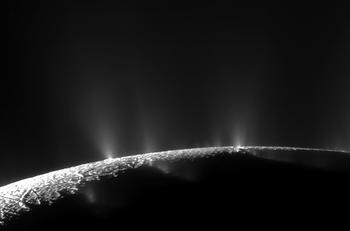Image of the south pole of Enceladus, showing dust emission (water ice grains) from cracks in the ice crust.
Image Credit: NASA/JPL/Space Science Institute
In the project, the dynamical evolution of dust particles in the Saturn system is investigated for a range of grain sizes using numerical integration of the dust trajectories. The motion is followed from the dust sources (moons, rings) to the sinks (impact on moons, rings, Saturn, and escape from the system), taking into account all relevant forces and mechanisms, like gravity, solar radiation, electromagnetic forces, as well as the interaction with magnetospheric plasma, leading to dust charging and erosion.
Ultimately, the model will provide the 3-dimensional distribution of dust in the Saturnian system, preserving the velocity structure and temporal variation throughout the Saturnian year. The model will be informed by data from observations, predominantly results from the Cassini orbiter mission that was exploring the Saturn system from 2004 to 2017.
